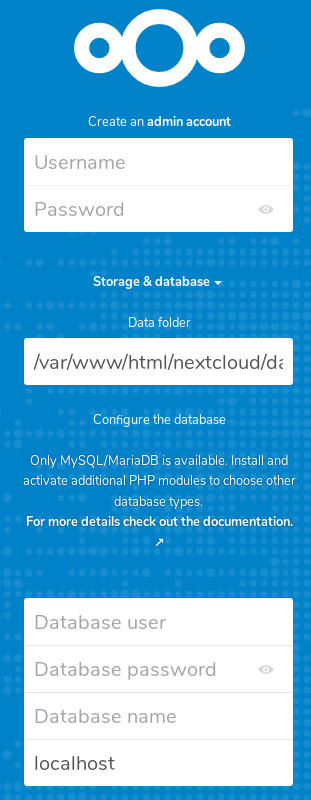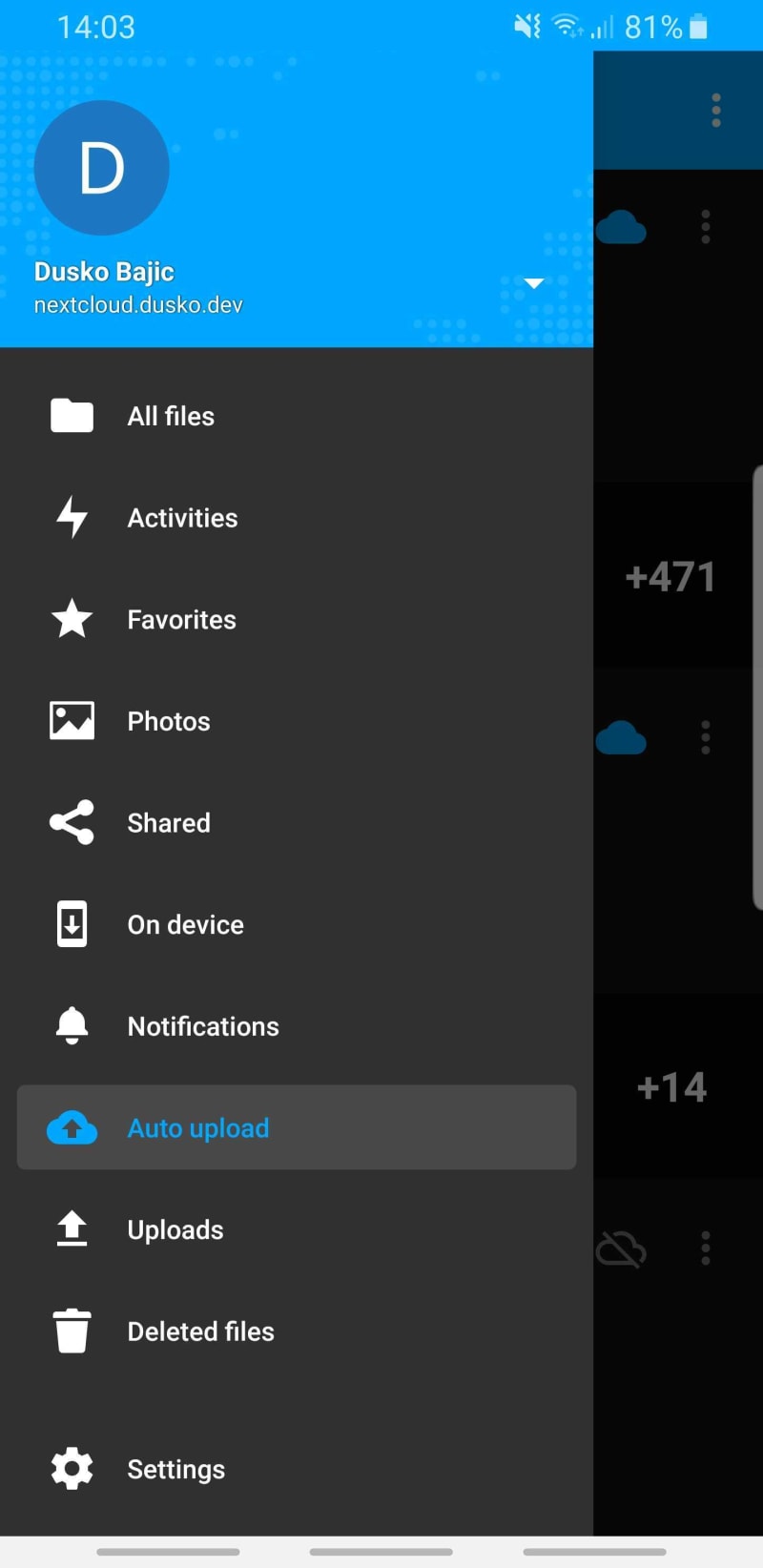This is a second post in a row in Moving away from Google services series. With the intention of replacing Google Drive, I have decided to try out a Nextcloud self-hosted solution.
Why Nextcloud
- It can replace storage feature Google Drive offers.
- It can upload mobile photos automatically, which replaces Google Photos.
- You can install it on your home machine.
- You can install many different applications inside Nextcloud, such as
- You can link external storage via SFTP or SMB
- Via WebDAV it syncs calendar events and tasks.
- Office documents management.
- Support for adding users, family management and its photos synchronization as well.
Basically, it supports wide range of features I consume from Google every day.
Private or "almost private"
If we're running a private cloud, then it should be hosted on a machine we physically have control of. I don't have a spare machine to run it on, so I've decded to purchase a smallest and cheapest VPS I could find. Time4VPS is great service with very acceptable prices. I've purchased
Linux 2 package for 4 Eur per month. It offers:
- Single core CPU on 2.6GHz
- 2GB of RAM
- 20GB SSD storage
- Linux distribution of choice. I've decided to install Ubuntu Server 18.04.
It's worth mentioning that I've tried installing Nextcloud on Raspberry 3 Model B at home. While the installation was successful and Nextcloud was running, unfortunatelly, Raspberry 3 have 1GB of RAM only, which isn't enough to host Raspbian, Nextcloud and MariaDB server, as MariaDB alone eats ~600MB.
It's important though, that if you have a Raspberry 4 at hand with at least 2GB RAM, you can install Nextcloud on Raspbian without issues. It'll work.
I have decided to go with VPS option due to my Raspberry performance issues. It's almost private solution, as mu virtual machine is somewhere in Lithuania.
Installing Nextcloud
Whether you choose to purchase a VPS or go with home setup, this guide assumes Debian based operating system in the background.
1. Install dependencies
Nextcloud is a PHP application running on MySQL database by default. Therefore we have to install its dependencies first:
sudo apt install apache2 mariadb-server libapache2-mod-php
sudo apt install php-gd php-json php-mysql php-curl php-mbstring php-intl php-imagick php-xml php-zip
2. Download and unpack Nextcloud
Navigate to /var/www/ directory. You can find latest Nextcloud version here.
sudo wget https://download.nextcloud.com/server/releases/nextcloud-19.0.0.zip
Extract downloaded package
sudo unzip nextcloud-19.9.9.zip
Make sure that directory structure looks like this: /var/www/nextcloud/ with the nextcloud contents inside.
3. Prepare database
- Execute
sudo mysqlto enter MySQL CLI. - Create nextcloud user:
CREATE USER 'nextcloud' IDENTIFIED BY 'nextcloud'; - Create nextcloud database:
CREATE DATABASE nextcloud; - Wire these two by adding permissions:
GRANT ALL PRIVILEGES ON nextcloud.* TO 'nextcloud'@localhost IDENTIFIED BY ‘nextcloud’;and then flush'emFLUSH PRIVILEGES; - Quit MySQL CLI:
quit
4. Configure Apache
User permissions
Our web server is Apache and user it creates is named www-data. Therefore, we have to allow this user to access to nextcloud directory so that Apache can serve its contents. While you're in /var/www directory, execute these commands:
sudo chmod 750 nextcloud -R
sudo chown www-data:www-data nextcloud -R
Configure Nextcloud
Navigate further to /var/www/nextcloud/config and open config.php file. This file contains basic configuration of Nextcloud setup and should be customized to fit our needs. I had a couple of push-n-pulls with this configuration until I make it correct.
sudo nano config.php
This is the example of my configuration:
<?php
$CONFIG = array (
'passwordsalt' => 'some_salt',
'secret' => 'some_secret',
'trusted_domains' =>
array (
0 => 'nextcloud.dusko.dev',
),
'datadirectory' => '/home/dusko/nextcloud_data',
'check_data_directory_permissions' => false,
'dbtype' => 'mysql',
'version' => '18.0.3.0',
'dbname' => 'nextcloud',
'dbhost' => 'localhost',
'dbport' => '',
'dbtableprefix' => 'oc_',
'dbuser' => 'nextcloud',
'dbpassword' => 'some_password',
'installed' => true,
'instanceid' => 'ocgn1qo2r675',
'overwrite.cli.url' => 'https://nextcloud.dusko.dev',
'htaccess.RewriteBase' => '/',
'preview_max_y' => '1024',
'preview_max_x' => '1024',
'jpeg_quality' => '60',
'maintenance' => false,
'twofactor_enforced' => 'true',
'twofactor_enforced_groups' =>
array (
),
'twofactor_enforced_excluded_groups' =>
array (
),
'has_rebuilt_cache' => true,
);
Note on some of these properties:
- trusted_domain has to be set properly, if you're serving Nextcloud via your domain. In my case it's a CNAME pointing to VPS.
- I was forced to set check_data_directory_permissions to false as the data directory I set to be used is shared between multiple users, + the path I've set is a soft-link and I had a hard time setting this up properly. Easiest way of going around was to set it to false and never look back.
- preview_max_x and preview_max_y is related to thumbnails. There is a detailed thumbnails explanation in Nextcloud: Honest review post. I have literally lost whole week on setting this up and I'm still suspicious if it works properly.
Enable Nextcloud
To make Nextcloud available on webserver, we have to play with Apache a bit. First, let's configure nextcloud virtual host.
Open nextcloud.conf from sites_available directory:
sudo nano /etc/apache2/sites-available/nextcloud.conf
Here is an example of my configuration which includes Alias and subdomain with SSL setup. Alias is just a showcase as you might want to serve nextcloud on example.com/nextcloud. In my case that's not feasable and I went with subdomain setup.
Alias /nextcloud "/var/www/nextcloud/"
<Directory /var/www/nextcloud/>
Require all granted
AllowOverride All
Options FollowSymLinks MultiViews
<IfModule mod_dav.c>
Dav off
</IfModule>
</Directory>
<IfModule mod_ssl.c>
<VirtualHost nextcloud.dusko.dev:443>
ServerAdmin my_email.com
ServerName nextcloud.dusko.dev
DocumentRoot /var/www/nextcloud
ErrorLog ${APACHE_LOG_DIR}/error.log
CustomLog ${APACHE_LOG_DIR}/access.log combined
SSLEngine on
SSLCertificateFile /etc/ssl/certs/dusko.dev.pem
SSLCertificateKeyFile /etc/ssl/private/dusko.dev.key.pem
<FilesMatch "\.(cgi|shtml|phtml|php)$">
SSLOptions +StdEnvVars
</FilesMatch>
<Directory /usr/lib/cgi-bin>
SSLOptions +StdEnvVars
</Directory>
</VirtualHost>
</IfModule>
Now we just have to enable the site and open it. Execute these two commands:
sudo a2ensite nextcloud
sudo a2enmod rewrite headers env dir mime
sudo systemctl restart apache2
Open the domain you've set and you should be greeted with Nextcloud config page.
Upon logging in, you can install necessary applications and go through Settings section, to restrict access and tighten up the security a bit.
5. Mobile app
By installing Nextcloud on private server and setting up everything correctly, next step is to connect the mobile application to our Nextcloud instance. As I have the Android device only, I've tested and used Android version only.
Go to PlayStore, and download the app.
On the first run, you'll be prompted to enter server url and credentials. Once you pass that, you should be able to see the files and setup Auto-Upload feature.
Mobile application is highly troubling product at the moment. It's review is part of Nextcloud: Honest review as well. Make sure to go through that post before you decide whether to install the Nextcloud or not.
This post is originally posted on: dusko.dev





Oldest comments (3)
This is for technically advanced users, it is there a more user friendly alternative?
If you are technical enough to have docker installed, then the Nextcloud installation is as simple as this command:
docker run -d -p 8080:80 nextcloud
Thank you for this. My company is looking to move from google to nextcloud for as much as we can, and this was a great primer on the setup. Jumping into the apps next to see how those work!